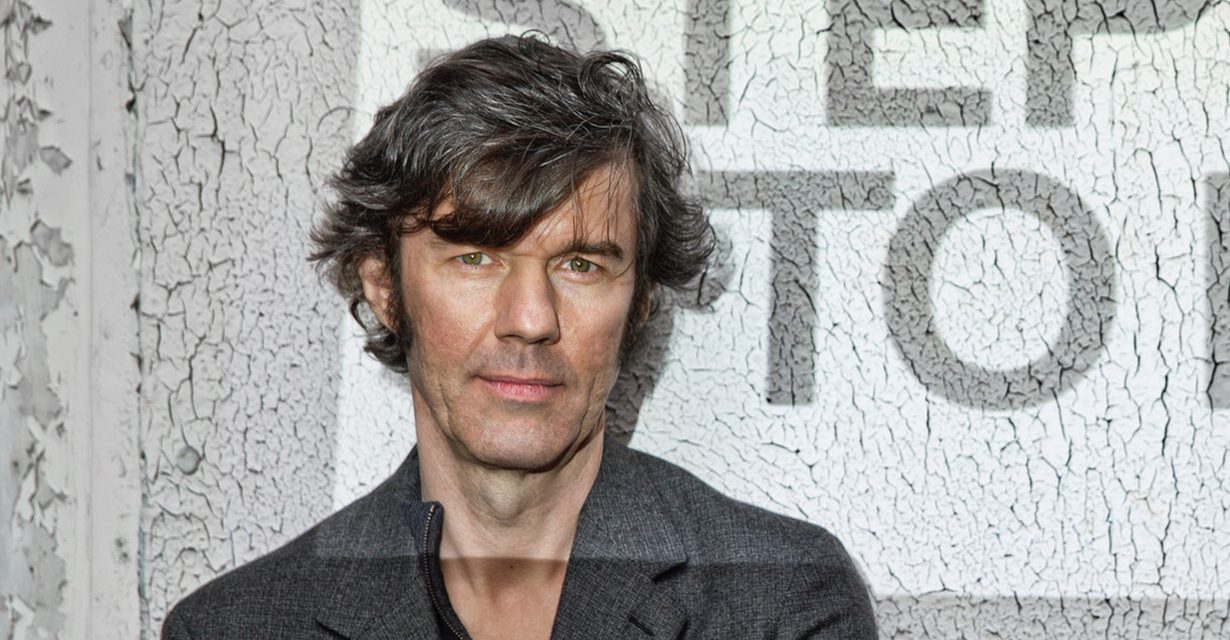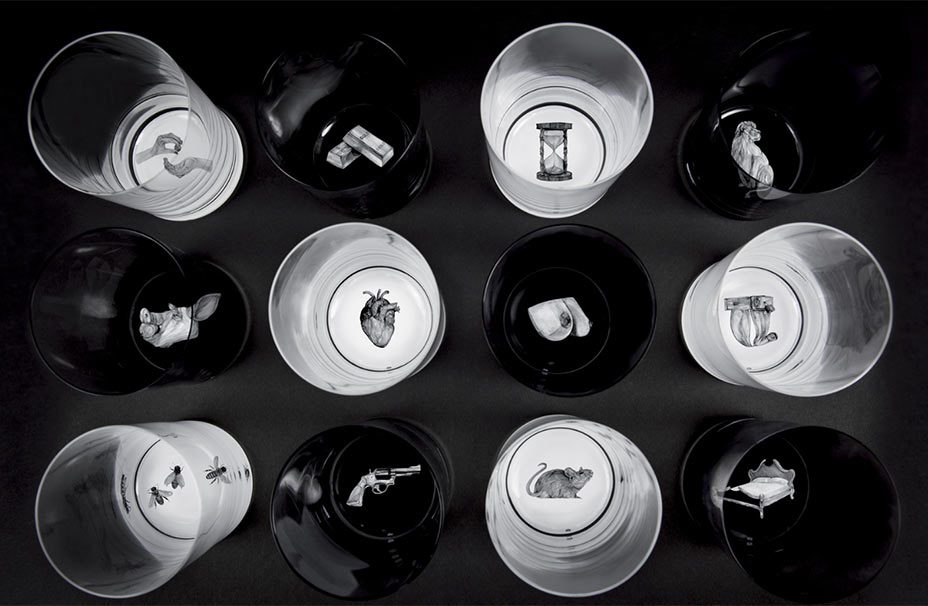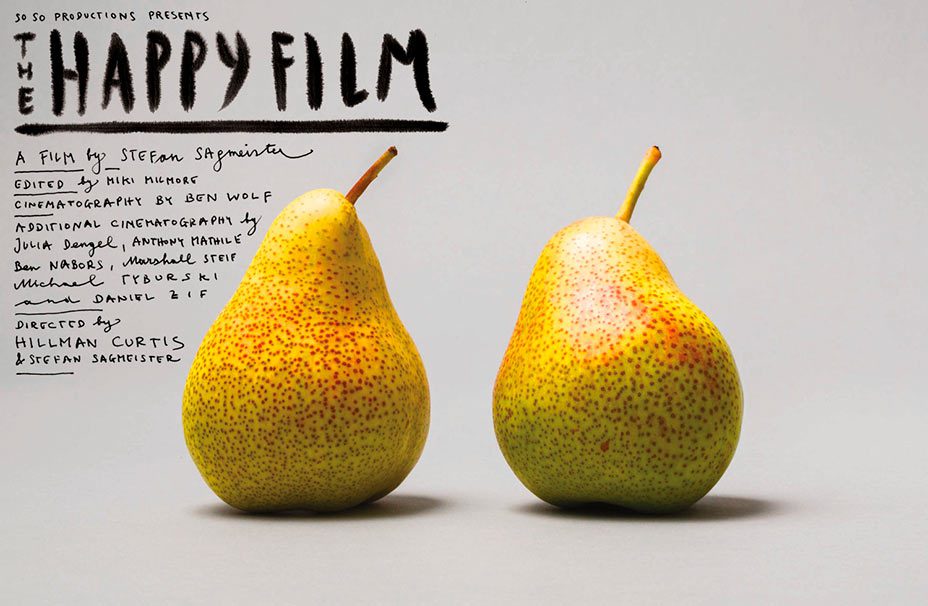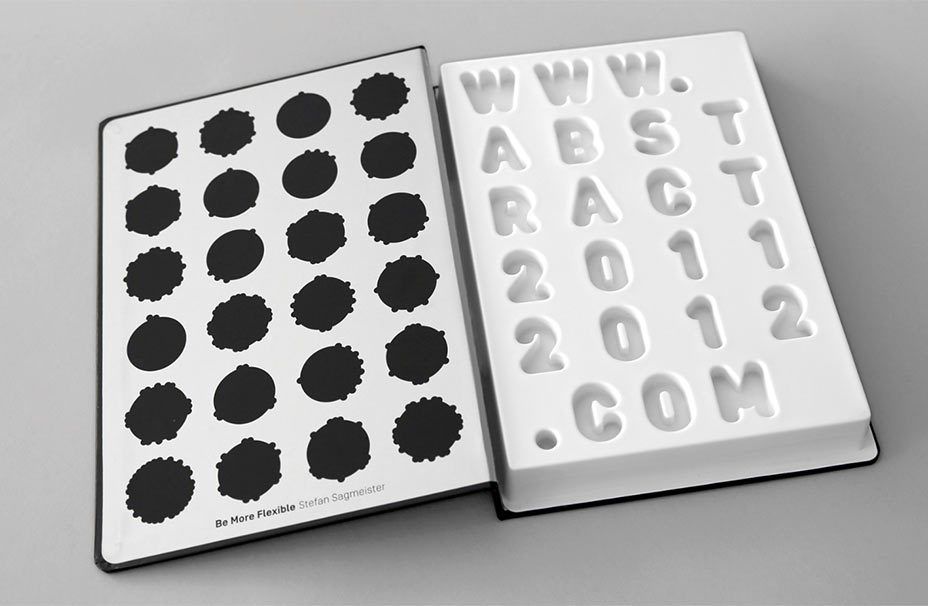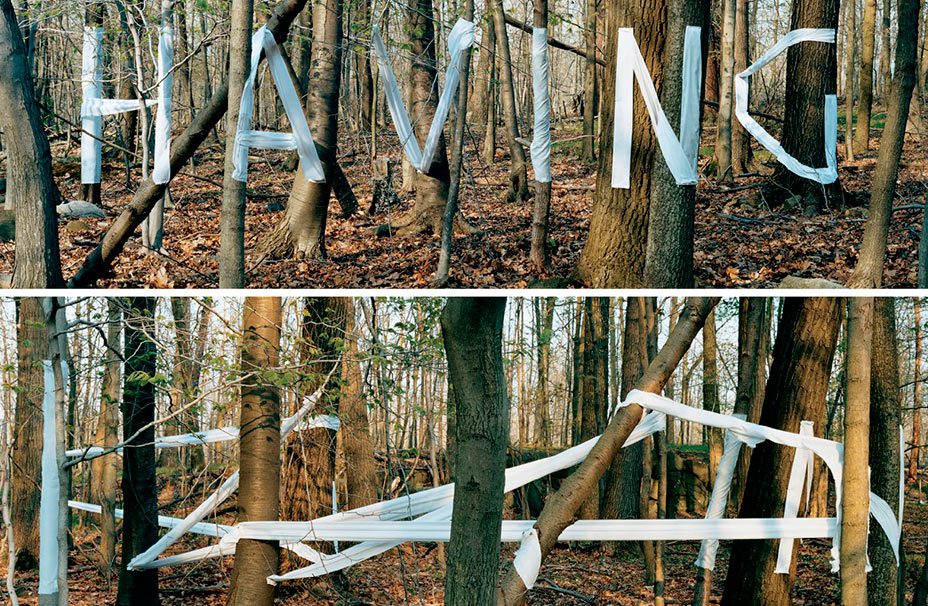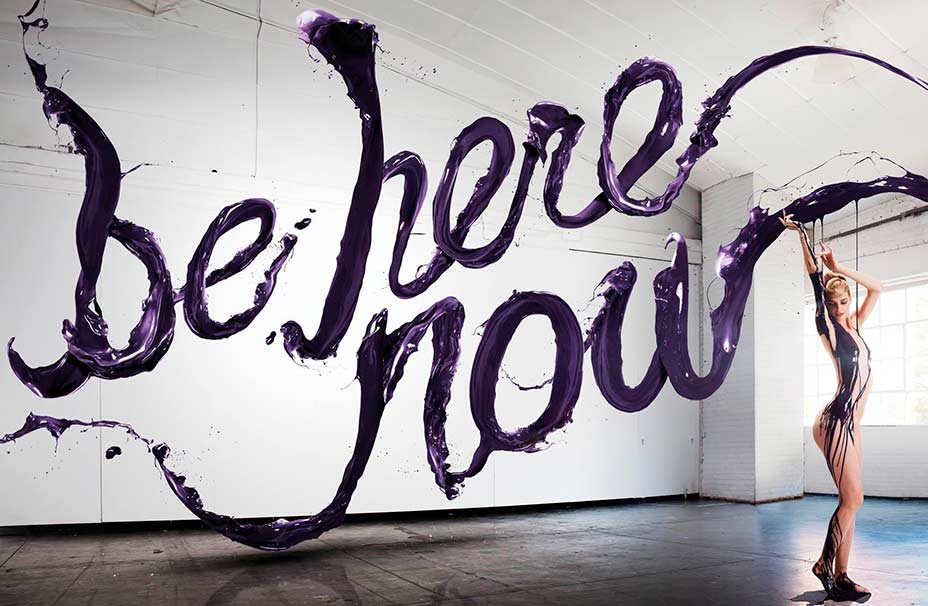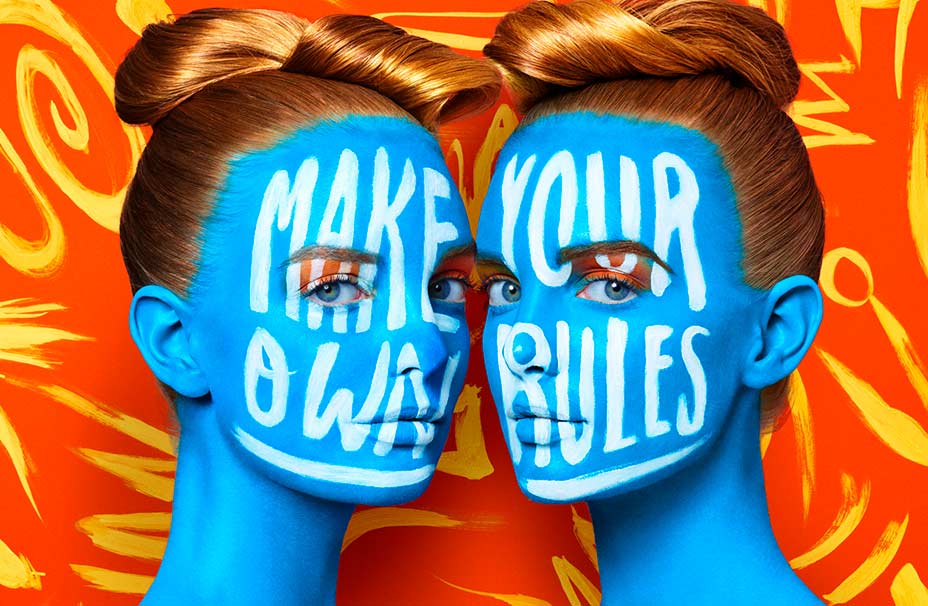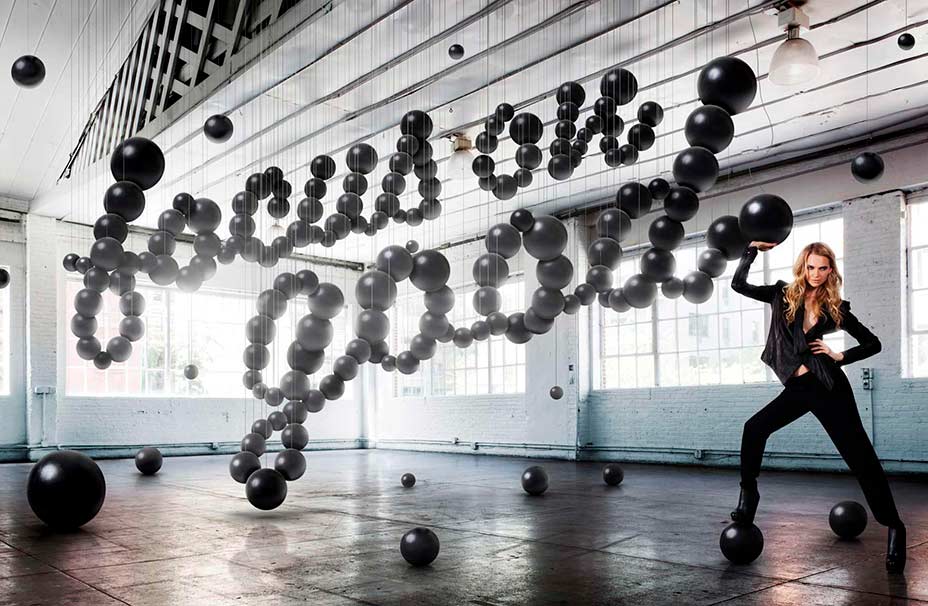Stefan Sagmeister is one of the most interesting, dynamic, diverse, controversial and well known designers today. Based in NY but raised in Austria, Stefan discovered his passion for design when he was quite young. Coupled with a love for music, his first work was in the music industry, where he created album cover for a wide range of artists including David Byrne, Brian Eno and Lou Reed. Beyond that, he and his studio, Sagmeister & Walsh, have designed for Barney’s, the MoMA, The Guggenheim, The NY Times Magazine, Levi’s, Adobe, Random House and dozens of others. We spoke to him in his apartment in NY. Here, he speaks of his upbringing and why graphic design is in his blood.
Below is a transcription of the Design In Mind interview with Stefan Sagmeister.
SS:
In Austria specifically, in the Alps it’s a very traditional place. Basically, you, for the longest time, you stay in the village you were born in. You’re going to die in that village and you basically take over the profession that your dads did. This of course is how names of Schneider and all those names, Tailor, started to be because this was the Tailor family and this was the Builder family and this was the Priest family.
My granddad actually made an apprenticeship to become a sign painter which in the late 19th century basically meant you were a graphic designer. The real profession for graphic designer didn’t really exist, it came in the very beginning of the 20th century in France or so. Where he was really doing his apprenticeship there was no such thing. His dad really forced him to take over the family antique store which was a tiny little store. He only practiced sign painting on the weekends. You can see one of his signs right here hanging on the wall.
Arkitektura:
Wow that’s great. That’s great.
SS:
He was a fantastic craftsman meaning he hand carved all these angles around it and it was his typography. That was the thing of a sign painter, you made the whole thing.
Arkitektura:
Amazing.
SS:
He didn’t really practice it professionally so our house was full with his stuff that he made on the weekends. During the week he really basically sold antiques and not very high end ones because the whole area was poor. His antique store was not a fantastic antique store.
Arkitektura:
Then your father?
SS:
My dad took over that store. His talents would really have lied in languages but he of course was forced again to take over the store and he transformed it from an antiquey store into something that was more clothing store and ran that quite successfully with my mother and my two older brothers took over that store again and divided it up. One of my brothers was doing men’s fashion and the other one was doing women’s fashion.
Arkitektura:
Interesting. Around 15 or 16 is when you started realizing that you saw the world differently?
SS:
I started to write for a little local magazine and then just found out that I actually enjoyed doing the layout, drawing the headlines and making some little drawings for it better than I liked the writing and since nobody else really wanted to do that, that was an open possibility. The magazine was somewhat culturally active as in they were organizing concerts, some festivals and some demonstrations that all tended to need some sort of graphic application. I had the chance at a fairly young age to make things and then get them printed. It was also low budget but it was still fun to make something, get it printed. We mostly hung those posters ourselves with glue on the walls and it was my first taste of what that could be and I very much liked it.
At the same time I also was in a terrible band but through that got interested in album covers and thought that that could be a fantastic occupation to figure out album covers. Then of course when I started designing in Vienna I got close to all the other possibilities of that field. Then really only got back to album covers much much later when I opened my own studio here in New York which was 10 years later or so.
Arkitektura:
Do you think you would’ve ended up in New York? Was New York something that you longed for without having seen it?
SS:
I think that I always wanted to live in a big city. For example, I definitely wanted to study in Vienna. I could’ve studied in Munich too but Vienna was the
biggest and so because of the furthest away from home after surrounding ones. Then figured out very quickly Vienna is not really a big city. It’s like 23 small towns close together, everyone with its own district, there’s 23 districts of Vienna and I longed for a bigger one. Even during my studies in Vienna I spent a number of my holidays in London and loved it. For me London was the pinnacle of Europe. To this day I’m very fond of London. I probably wouldn’t move after 25 years in New York, I probably wouldn’t move to London because I always feel the two of them are sister cities. If I would move I probably would want to move somewhere totally different. I still I’m very, very fond of London, yes.
Arkitektura:
It’s not like you just designed album covers. [The work] was for some of the most creative, in my mind, some of the most inspiring to people, musicians that I feel have moved me the most: Brian Eno, David Byrne, Lou Reed. I just thought to myself gosh to work closely with these creatives I wondered how you both inspired each other and how you felt like working with them changed you? I’d be curious to know how you think you changed them.
SS:
Maybe obviously the ones you mentioned are all very different from each other. I would say that Lou was probably … The least visually interested of the three but he did think of the cover as very much part of the music so he was always very kind to me because he figured this was part of the music. We did one video for him where I saw a different side of him because that he saw was part of the promotion and he didn’t really want to have anything to do with it.
I got along super well with Lou … Maybe because I really loved the music and wanted to really visualize it. The essence of what he was about was always super important to me and doing that to be of course very much on his mind. We had basically no problems. In all those stories that you might be aware of how difficult he is, it was mostly I think coming about because he really hated the entire surroundings of the music industry and giving interviews was part of that. Of course he sometimes behaved terribly to journalists. I remember picking up a copy of German Rolling Stone in the Frankfurt airport where the second sentence that he said to the interviewer was, “This is the bane of my life that I work with idiots who let assholes like you through to me.” That is one fantastic sentence.
Arkitektura:
That’s great. As a journalist terrifying to hear that but great. I actually heard an interview with him there was this guy and I wish I could remember what they were called. There were these tapes, this guy did great interviews that were of terrible sound quality in what sounded like a basement.
He was so charming and so obliging and it was such a different part of Lou Reed than the one that you hear about. I realized just how special he is on that kind of idea of him is not accurate. How about David Byrne?
SS:
With all the musicians that I worked with David is by far the most sophisticated visually by far. In many senses I think that he’d probably be the one of the very few true renaissance people in the world of music. Yes I think probably number one is music but then he is so interested in theater, so interested in dance, so interested in visual arts. Even I remember we went through this exercise with David, can he sum something up? Can he sum the talking heads up in a sentence? The way he summed up the Talking Heads was they brought funk and the visual together.
Arkitektura:
Interesting.
SS:
From the beginning there was a very very big deal to him. If you’re talking visuals with him I always learned a lot. He is also because of the music, the ideal collaborator. He gives a direction and then leaves and then really leaves you alone. I think because he did so many musical collaborations with different musicians where on all levels like some he was totally in charge but then some where he would only do a tiny bit. He’s just used to working with people and get the best out of them. That made our visual, what we could contribute extremely easy. For a rock star he has a surprisingly tiny ego, also very rare. He really doesn’t mind where the idea comes from. It’s like the changes that David made and you could feel them were always with the project in mind. Never with I would want to insert myself here because I would want to have more ownership of this project.
Arkitektura:
It’s brilliant and it’s also great to work with someone that brings out the best in you.
SS:
Yes. He would definitely be one of my very, very favorite clients that I’ve ever worked with.
Arkitektura:
Also that’s an interesting question which I’m sure you go through these questions because when I earlier said graphic design I felt god that’s so limiting so we’ll just stick with the word design which also might be limiting. It’s a branding question like you’re trying to figure out who someone is and it’s such an intimate process that process. I’m thinking about these clients, we’re talking specifically about music but you had some other amazing clients. What is it? Is it luck? Is it intention? Is it incredibly hard work? Is it passion? What is it?
SS:
You mean business that clients came to us?
Arkitektura:
How did that happen? How did your life evolve that way?
SS:
I would say the music world I definitely wanted to be in and I went after it. Like I used to work for a studio that was run by my hero by a guy called Tibor Kalman and Tibor moved to Rome to do Colors Magazine, that magazine that he had founded. When I contemplated my next steps it was all clear that I would open my own studio, it was clear it was going to be small and it was clear it will focus on the music industry.
Of course I didn’t have any music clients I had at that point I think 2 CD covers in my portfolio. I went after it meaning that I went to see all the record companies and offered my services and they all said, “Yeah, the work is fine. Let’s work together,” but none of them really did. It really started to work when I was able to design a cover for a friend of mine a small band called HB Singer where we designed the cover that was ultimately nominated for a Grammy. That then made clear to the larger labels we can actually execute something to a certain degree.
That really made the difference where it changed from the promise we will work with you to the actual we will work with you. Then it went pretty fast. We did some ads for David Burn. We did some stuff for Lou Reed. David Both on Warner Brothers at the time. Warner Brothers was a fantastic label for us to work with. They were not only established but had I would say from my point of view a very artist friendly demeanor. They had strict rules which I being born from 5 miles from the Truman border had no problem to adhere to, but there was also it came with advantages like they knew about that line.
The whole thing went in a somewhat orderly way but also because they were headquartered in Los Angeles once they gave you the job, but they mostly gave you a job for a New York client. As long as the artist, the musician was happy and there was nothing on it that prevented them from being able to sell it, as long as there were no sexual things on it or so, they were fine with it. It was basically then really between myself and the band.
That removed a lot of troubles that we sometimes had as New York based large labels where you became this play ball between many executives at the label, many members of the band, possibly the management company of the band that became this 3 different committees with 3 different desires and goals where you have to fight not to wind up with something that nobody hated but also nobody liked.
Arkitektura:
That sounds like a nightmare.
SS:
Yes. We’ve been through a number of those as well.
Arkitektura:
This small band was the breaking point?
SS:
Yeah. I think it’s so normal. Most people that do anything go through these things. I literally before you came in I quickly read the first 3 pages of the Moby biography that just came out. Basically he’s talking about how his first big break was because he managed to deliver a mix tape to this club in the meat packing district and against his complete utter surprise they gave him a call and he got a Friday night to be able to DJ there. That’s definitely what he wanted.
Ultimately it’s probably the case for most people who do anything is there is a desire to do it and then I would say there is mostly hard work behind it. I’ve on the musician side never met a single musician who was lazy and successful. I’ve met lazy musicians but the ones that we’ve worked with who were successful they all are very hard workers. They all really want to do the thing that they want to do. Those 2 things are always part of it.
Arkitektura:
In one of the interviews that someone’s done with you I think they said what advice do you give or something. You said, “Be good. Be good to people and work incredibly hard,” or extremely hard or something and it’s true.
SS:
Along those lines I just talked to one of our young designers and his opinion was that-
Arkitektura:
You mean on your team?
SS:
On our team. Yeah. His opinion was that there was always a crew of 5 or 6 people at SVA who worked night through and it’s those 5 or 6 people who now have good jobs. Nobody outside of those 5 or 6 people really has a good job.
Arkitektura:
Interesting.
SS:
The way he told it it was basically completely exclusive. It’s those 5 or 6 who really now have a top job in New York and none of the other ones. It happened for none of the other ones.
Arkitektura:
You feel you’ve worked extremely hard too?
SS:
I did. Yes I did.
Arkitektura:
I did, not in the present tense?
SS:
I work much less now than I used to. Yes. When I was in school or even as a young designer, 16 hour days all the time, and I haven’t done a 16 hour day in a long time. I also think that this is necessary. I think this kind of this for me, but in general it was not healthy. It was absolutely necessary but I don’t think it’s healthy to do this for a lifetime. It also to end out I’m actually not a workaholic. I wanted to live a life besides design. It’s also necessary that design is informed by life for it to be organic and real. I think there is a big danger if I would’ve kept, and it was a very clear decision when I opened the studio that I’m going to work very hard during the day but it will end at 7:00 in the evening. That there will be something else happening. I will only work at night and on the weekends if there is a real emergency and that it’s not going to be casual.
Arkitektura:
That’s great. I think that’s incredibly important too. I come from a place, California, that’s all about work and life balance. Do you think Tibor would say that? Do you think Tibor would agree with that?
SS:
Yes I think he would. Tibor died very, very young. He died when he was 48 and so I think doubly he would. He had a full life and he has 2 fantastic kids and had a wonderful, wonderful, wonderful life. I think that Tibor lived a very full life. I can also say that he was Tibor’s early death was one of the influences for me to take the sabbaticals because I felt that it’s just really necessary to in life but also in design to get the most out of it and not to keep on doing things just because I got used to keep on doing them.
Arkitektura:
In describing Tibor’s full life you mentioned that he has two wonderful children and he has a wonderful wife. I was surprised that you’re not married that you don’t have children. Was that a conscious choice?
SS:
That changed in my life. Originally when I was young I never wanted to get married or have kids, like consciously. Now I think it’s different. Now I could see both directions. I could still see that could possibly happen but I’m not truly pursuing it. I would say if it happens great, if it doesn’t happen that’s fine too. I specifically of course in New York I know a good number of people who are now in their 70’s and 80’s who don’t have kids who I think had very full lives. I really truly believe that both is possible. There are different paths, but I do think both is possible.
Arkitektura:
I’m also curious about the human body and something that you’re very well known for and now your business partner Jessica Walsh is very well known for, is the exposure of your body. Why do you think the body is so powerful? I’m actually reading this book called Talk Dirty to Me which is about sex, the way in which sex is understood, viewed, shared and experienced. I’m on this section about Adam and Eve and the hiding of the body. There’s an understanding as to why historically the body has become taboo. I just wanted to pose the question to you why do you think it is so powerful?
SS:
There’s a whole bunch of reasons. One is a feeling that I’ve always had was to make design more emotional and more human. Specifically coming out of Austria, being influenced by my study days this other flows and then later and that whole idea from the 1920’s to bring the machines into design, to make it more objective, to remove the designer from it and to have all these machine like rules. Basically the idea was to have it even if it was hand made to make it look like it’s been made by a machine. One easy way to avoid that and I think that by now considering we are 100 years past it’s really necessary to avoid that, is of course to both from a content point of view make it more humane but maybe also from a visual point of view.
I do know from a pure viewer perspective we love the human body incredibly. I know part of this I know from my guts and this was driven home again by a visit when we published a second book I did a big book tour and I came through Seattle and I also did a talk for the people at Amazon. They could tell me that the most clicked on book covers, they of course have numbers in the billions, is the human face. Number two is a pet. These are indisputable numbers. Of course when I heard that a lot of things became clear to me.
It suddenly became clear to me why every magazine has a face on it. You can even see every magazine who sold on the newsstand has a face on it because that magazine is depending on the decision on the person who is at the newsstand. Every magazine that is the subscription who is not sold on the newsstand doesn’t have a face on it because it doesn’t matter because they subscribe to it anyway. They make the decision earlier which is why the New York Times magazine is one of the few mass magazines who doesn’t have to have a face on it. All the other magazines still have a face on it. Clearly we love it or the fact that this is so boring, that the newsstands confronted by a hundred faces is less important than our love for the human face.
This of course is also true for the entire body. We have unbelievable possibilities of subtly in seeing difference because we know it so well. As far as the naked body I think initially this was used by me or in the studio more humorously. The naked body was never a big deal for me coming from Austria. We went to nude beaches all of our life so definitely the main nude beaches in Vienna on the river they were all nude so it was not a big deal. Over here in the States it was a big deal. I basically just took advantage of that. Then later in the studio we made a couple of jokes on the former jokes.
The main core of basically breaking away of machine made I think is still a very big part of it. If you take the vast majority of what is communication design, it doesn’t matter if it’s a website or a brochure or a traffic sign or whatever it might be. You ask somebody on the street who do you think made that sign? Most people will say a machine made it, a computer or something. They would be somewhat unaware that human beings sat through endless meetings and we contemplated these things. That’s still left over thinking from modernism that things should look like a machine made them which is in communication design one of those thoughts that only exists because it never really has been questioned properly.
If you’re a corporation that is issuing a brochure that on purpose looks like it’s been made by a machine it’s the equivalent to you saying I’m not going to have any phone operators, I’m just going to have answering machines dealing with my audience. Which no corporation in their right mind would do but visually they’re still doing exactly the same thing which is stupid.
Arkitektura:
I was just thinking about you taking on a partner, you totally didn’t need to take on a partner. Why did you take on a partner?
SS:
Over the many many years that the studio has not been operating, we opened in 93, so this is now 23 years, there has always been strong designers, still under me but strong number 2’s I would say at that point. By design these were very good, excellent, ambitious designers that went mostly off to open up their own studios. Friends, many of them I’m actually meeting later on tonight for dinner.
Jessica was brilliant and of course also would’ve gone and opened her own space. After having gone through this process numerous times I wanted to change that and she was unusually dedicated and unusually talented and thought, “Let’s try something new.” This has now been 4 years ago I think and it’s going really well. It came with benefits and advantages that I had never counted on that it would come with. I think neither one of us is truly married to the other so I think this will work for as long as it is a good thing for the both of us. We might do something different but right now it works wonderfully.
Arkitektura:
Because you’re not married, is that what you just said?
SS:
No meaning, Jessica is happily married.
Arkitektura:
Yeah because you’re not married too.
SS:
To her wonderful husband. We have never been a couple because I know that sometimes some people misunderstood the fact when we announced that we were both naked that there was some sort of coupling going on but that was never the case. We were always very professional partners.
Arkitektura:
We’ve been raising this word design and it just seems even in this conversation and often then when I even describe what my husband does it just doesn’t seem like the right word to use. I don’t know what the alternate word would be. What do you think of the term?
SS:
Design is pretty open but I see it more as an advantage than a disadvantage. It means that we can in a single year finish a documentary film, we can do some furniture, we can design floor coverings, we can design a brand for a museum, do some stuff in the hotel world, and it all be design. Really have be involved in professions that part of the documentary film was choreographing dancers. This used to be all very different professions and you basically had to make a big jump and announce I’m not doing graphics anymore, I’m now into choreography. Because the term is so big it allows us to be basically to not get bored.
Of course at the same time with technology there is a danger that the day to day profession got smaller because so many of these different things all work in front of the same screen. There’s a danger that the profession becomes actually more boring, at least from what your day to day task is. By opening it up with these different things we counter that technology bit and just basically stay interested.
Arkitektura:
I can relate to that because as a journalist I do so many different things. I do documentaries, installations, art pieces and radio pieces in short form, long form and it’s true it does keep you very interested and I love that part of it. I actually made a documentary on happiness many years ago when I was first in my year.
SS:
Meaning a documentary film?
Arkitektura:
Radio.
SS:
All right. In what direction did it go?
Arkitektura:
It was inspired by traveling across the country I wanted to interview people about the pursuit of happiness and how they would define happiness.
SS:
These were just any people or these were experts?
Arkitektura:
Any people and then I interviewed experts. Paul Ekman who’s a psychologist had done all this work on facial expressions and the way in which they relate to happiness. Then Daniel Gilbert-
SS:
Mm-hmm (affirmative). I know him.
Arkitektura:
Then the economist Daniel Kahneman
SS:
Sure I know him too.
Arkitektura:
These big names in happiness. They’re I wouldn’t say a handful but they’re the people you go to. I learned a lot. When I heard that you had done this documentary on happiness I was really excited by it. I also thought, “Gosh an Austrian doing a documentary on happiness.” I’m married to an Englishmen and not that he’s very English, he’s not actually, there’s a reason he’s living in the States. This notion of happiness and the term happiness is so stigmatized isn’t the right word but let’s use it. What was that process for you like? Why happy? Happy it’s actually also a very hard term to use. One of the things you said about design was that you want to support the well being of others. I don’t think you’ve said you want to make other people happy necessarily.
SS:
There’s a couple of things there. I would think that well being is part of happiness, it’s the middle term out of the very short and the very long kinds of happiness. You’re totally right. If you look at Vienna’s most famous citizen Freud and one of my favorite quotes of him would be that all we can hope for in life is a transformation of hysterical misery into common unhappiness. That’s a very typical Viennese thing to have. For one I think that of course was a reason why I always felt more at home in New York then when I lived in Vienna.
At the same time it of course was the reason why I felt quite nervous about bringing the Happy Show the exhibition that was originally a side project of the film but became quite a stand alone thing itself to Vienna. I really thought that we’re going to get a lot of negative reviews and that it’s going to be more like a in comparison to how it was successful in the United States and in Canada. The exact opposite happened. It not only was the show in Vienna the most visited out of all of the cities it was in but it also created an audience record for the museum that’s been around 150 years. It had the most visitors in the history of the museum called the Happy Show.
Clearly it was the outcome, with open arms. My explanation for that now would be that these pieces of information or that content is just not available as readily there and was eagerly welcomed. It was super successful in Paris too and is now in Frankfurt and is very, very successful there as well. It happened exactly opposite of what I would have expected. In my own case that whole subject really sneaked up on me slowly. There was a very long time ago maybe as much as 10 years ago I first did a talk on design and happiness and that basically was just a look at our own work through that kind of filter.
Like what is the kind of stuff that makes me happy as a designer? What is the kind of stuff that I could possibly think makes an audience who sees this stuff somewhat happier? Is that even possible to look at it through that filter? That talk just had very good feedback. One of the wonderful things about talking to an audience is you get the stuff back right away which for a designer is super interesting. That talk created much better and much more feedback than when I just presented the work this is what we did last year and this is what we’re doing now kind of thing.
When I was on the second sabbatical in Indonesia we did some furniture and a friend complained that it’s not that this furniture is sort of a waste of my time and that I should do that I would have some sort of responsibility to create something that people can do more with or that’s more useful to people. When I thought about what that could be that subject came to my mind again and I thought maybe I should do a whole film on it for a number of reasons. One because I thought maybe it would be useful for people.
Second, that it would force me to do proper research in that area that I’m interested in anyway. It was not because I was depressed and wanted to get out of a depression. Normally if I’m not in a good shape I do nothing. It’s not like that I start big new projects in fields that I have no clue of what I’m doing. That proved to be the case. It definitely forced me to do all the research. Doing it as a film I hoped it would be a challenge and I probably got more of a challenge than I was ready for. There were definitely many periods while doing the film where I was incredibly frustrated and pun intended also very unhappy doing it. The whole thing was difficult. I’m glad it’s done.
Arkitektura:
You’re glad it’s done. I was going to say were you glad that it was difficult?
SS:
No. It would’ve been much more enjoyable if it would’ve been easy, no doubt about it. Of course there is this thing that’s the pain in the ass thing that if it’s not difficult it’s likely because I’ve done it before and I’m going to get bored by it.
Arkitektura:
The Tibor quote.
SS:
It’s just I think that there is this inherent thing in us that we probably only have the possibility to go to the edges of our abilities when we are in a world where we don’t quite know what we are doing. If we do know what we are doing we do the same, we repeat ourselves and not do it very well. This is strangely even true for the masters. I think last week there was an interview with Steven Spielberg in the New York Times where he’s talking about exactly that thing. He said that all his best work was done in a place where he had no clue what he was doing. He talked about the notoriously difficult shoots that he had with Jaws. He still says that this was the unhappiest time of his life but it only became good because he had no clue of what he was doing. Then when he did, some of his films they never really became good because he was too satisfied and he was too clear it’s going to be good because he had done something like this before.
Arkitektura:
I have to respond to that. One is one of the interviews I did for the Happiness project
was with Mihaly Csikszentmihalyi. One of the interesting things about it was that your happiness one of the aspects of it was that you always have to be aspiring beyond what you think you can do. Then it keeps you engaged. I also think about Apocalypse Now and the making of Apocalypse Now which is Heart of Darkness and just how horrible it was and what a torturous time it must have been and what came about from it.
I thirdly thought about that quote that Tibor said because I casually can call him Tibor. Tibor Kalman said about don’t do something 3 times because the third time you’ll get bored. I thought that was true, interesting and important and not always possible. You said you would never do something on happiness when you were down. I guess maybe people assumed that you were down and that’s why you did it. One thing that you did say that I really loved is when you are feeling stressed you sometimes you imagine yourself in a truck driving through Siberia. Can you just relay that story?
SS:
I think there’s time when I got anxious at night, some thought comes in from the time during the day and I spin that thought and I figured out that all I ever get is anxious and I never really have a solution for that thought in the middle of the night and it really gets me nowhere. I might as well do something completely different. What a reoccurring thought is that I’m picturing myself driving through some extremely cold climate. It might be Siberia or something similar but some sort of adversary is outside, bad guys, cold weather, or ice or whatever it is and I’m completely cozy in my extra warm truck with all my supplies in there. It’s sweet and wonderful. Then of course I never really have a solution for whatever thought I had during the day but at least I get a good night sleep and I can figure it out the next morning.
Arkitektura:
I love that imagery.
SS:
We even have the whole thing animated in a quite beautiful animation that we ultimately never used in the film sadly.
Arkitektura:
Really?
SS:
Yes. If there’s ever a DVD with extras it’s going to go on there because it’s a beautiful animation, all illustrated by a wonderful illustrator by Yuko Shimizu.
Arkitektura:
Very cool that you did that. So it’s obviously important, close to your heart.
SS:
Yes.
Arkitektura:
This is my last question. Ayse told me something really interesting today which I didn’t come across in a bunch of the interviews I read but I’m sure you’ve talked about which is that every week you have a list of what you want to accomplish. It’s not like I want to get this project done or I want to write this email but it’s something more emotional like that. Something more moral. I’d love for you to share that.
SS:
I’ve been doing it for many, many years. It’s just roughly 12 points on it things that I want to be like. Like there is stuff that I think I’m not so good at that I should be good at like help other people, or make sure that I spent time with friends not just with acquaintances, which because I’m living in New York can become a danger. Stuff like that. I rate myself on it once a week, normally on a Saturday or on a Sunday I take 2 minutes out and I rate myself quickly. It’s normally if I’m doing good in those things it’s normally been a good week. I feel much better when I’m good in those things and when I let myself go like I helped nobody, I whatever the points are I normally had an unhappier week. My sister actually does it as well and we always suggest 1 or 2 new ones for the other. Like from the outside like she asks, “What do you think is missing in my life or I should be more like?” I make more suggestions and she does the same for me.
Arkitektura:
That’s great. That’s important. This is my real final question. This might be hard to answer because it might seem like you’re praising yourself. What are you most proud of?
SS:
I don’t know. I couldn’t say. I could easily say what I’m most proud of my sister. For myself, and I’m not even like I’m not a particularly humble person so I’m not even afraid of something or full of myself also. It would be difficult to say. I could say I could probably do it with a more narrow sense like as far as projects is concerned or so. For all my life it would be difficult.
Arkitektura:
What are you most proud of your sister?
SS:
Kindness I think. That she’s a kind person. Yeah.
Arkitektura:
Probably says a lot about you too.
SS:
Maybe.


